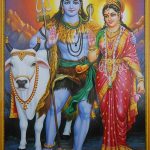Parvati, goddess of the mountain, Himalaya, primary wife of Siva, mother of at least two of Siva’s sons, is by far the most complicated of Hindu goddesses. She is given differing and often contradictory natures by the three main perspectives of later mythology—Saktas (those who worship the divine mother), Saivas (those who worship Siva as the Supreme), and Vaishnavas (those who worship Vishnu as the Supreme). Scholars often classify Parvati as a “cool,” or orthodox, manifestation of Devi, yet she also has her own “hot” aspects.
Parvati is complex even as wife of Siva and mother of two sons. Part of the tension derives from the ambiguous nature of Siva—both an ascetic and a husband. Some myths attempted to preserve his asceticism even though he had sons. Some made a concession: he had to end his austerities (tapas) to provide a divine son by Parvati in order to conquer evil. Siva was aroused from his meditation (or austerities—not always the same) by Kama, the god of love, to marry Parvati. However, an ascetic should not be aroused by Kama or actually consummate marriage, so Parvati’s motherhood was often denied by Saivite versions. In these versions, it was because these sons of Siva were either Siva’s creations from his mind or by Parvati’s own mind-creations, that Parvati acknowledged Ganesa (originally named Vighneshwara) and Subrahmanya (also known as Skanda and Karttikeya) as her sons. For more details on the many versions of the story of each of these two sons, see the individual entries. Yet, there were also several more children—another son and daughter, Andhaka and Ashok Sundari—again raising the question whether they were mind-born from one or the other parents. Many other sons of Siva, such as the sage Durvasa, were
Parvati, daughter of Himalaya, wife of Siva, and one form of the Mother, Devi
accounted for alternately as manifestations. The idea of manifestation of the Supreme is less mythical, less anthropomorphic, and less problematical—and does not require a real wife or mother.
There are a number of accounts that are not ascetic in regard to paternity issues. Several semi-divine beings come from the love play (coition) of Siva and Parvati: Andhaka (a demon) and Hanuman (a divine monkey). Parvati could be quite rambunctious in her love play. It was said in the Valmiki Ramayana that Parvati and Siva’s love play rocked the foundations of the heavens and the earth, so both the gods and earth complained to Siva. He stopped, but Parvati became angry. She cursed Bhumi-devi (mother earth): she would become many forms and be the wife of many. Parvati also stated that, since Bhumi had prevented her from having a son, Bhumi-devi would have no more children. On another occasion Parvati cursed chitraketu and his wife for laughing at her love play with Siva, which they chanced to see.
While Siva and Parvati were married and thus should have served as a divine model for the householder life, their relationship was not always desirable. Siva was usually the problem. One day Siva had behaved so badly, abusing the devas (gods) and his wife Parvati, that she decided to leave him. In order to prevent this, Siva discarded that portion of himself that was making life miserable for everyone—to be born as a sage, Durvasa.
Another time Siva received a woman visitor named Madhura at Kailasa while Parvati was away. Madhura came to worship Siva but was rewarded with special favors. When Parvati returned to Kailasa, she saw Madhura’s breast smeared from the ash of Siva’s body. Parvati went into a fury and cursed Madhura. Siva was not able to do anything.
When Parvati was first born as Sati, the daughter of Daksha, she wedded Siva. This episode complicated Parvati’s character beyond most mythmakers’ abilities to restore clarity. Parvati would be the eternal wife of Siva, yet it was Siva’s angry sweat as Bhadrakali (an aspect of Parvati), coming to protest Daksha’s snub of Siva as Sati (another manifestation of Parvati) and killing Daksha, Sati’s father. Sati burned herself in Daksha’s Brahmanical fire sacrifice, becoming the paradigm for “widow-burning” (sati) as an act of purification.
When Siva learned of his wife Sati’s self-immolation in the sacrificial fire of her father Daksha, he loosened his matted hair in full anger. Out of this angry energy was born two attendants: Veerabhadra and Bhadrakali. Bhadrakali was Parvati in another form. Siva sent Veerabhadra and Bhadrakali to kill Daksha. Even though Bhadrakali was Parvati’s manifestation, her actions were seen in the myths as Siva’s karma, making him a brahmin-killer. It was Siva, not Parvati, who had to do penance.
Parvati seemed to need to be where the action was and sometimes got into trouble because of it. Parvati complained to Siva that she had not been given a role in Vishnu’s Rama incarnation. Therefore, Siva caused her to lose consciousness of her true nature and be reborn as Lanka-Lakshmi, a doorkeeper or guardian in Lanka for Ravana. She fought with Hanuman who knocked her unconscious with a blow from his left hand. When she regained consciousness, she remembered that she was Parvati as Bhadrakali. She thanked Hanuman and returned to Kailash and Siva. Parvati’s role in the Krishna incarnation was most dramatic. In order for Krishna to escape death at his birth by the hands of his evil uncle Kamsa, a baby girl was substituted. As Kamsa tried to kill her, Bhadrakali appeared in full glory and power.
Parvati is worshipped today in many forms, beginning with Kali in the Sakti cult, Tantric forms like Candi, Camundi, milder forms like Gauri, Karthyayani, and so on. Candika was the furious aspect of the Goddess for those who interpret all her manifestations as those of the Supreme.

